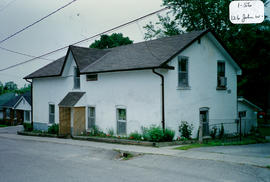2 Holland Street East - The Village Inn
- CA BWGPL GJ-HB-2017-03-24-02
- Item
- 1995
Part of George Jackson fonds
The Village Inn is located at 2 Holland St. East (on the corner of Holland and Simcoe Streets). There had been a hotel located at this site before the great fire of 1871. The building in this photo (1995) was built in 1920 in the Ontario Vernacular style. The original two-storey, cement building contained living quarters upstairs. One of the early inhabitants was Dave Watson, a farmer from the Scotch Settlement. He was one of the first to work with Professor Day in bringing about the drainage of the Holland Marsh. The ground floor was a grocery store in the early 1930’s (or before it was bought by Jim Gray and his wife). It was separated by a central entrance downstairs.
Ken Morris bought the building around 1933 or 1934. Renovations were done by Art and Len Saint in 1937. The building was converted into the English Tudor-style hotel currently known as “The Village Inn”. A one-storey addition was added later (on the east side of the building) to contain a restaurant and ladies’ room. Under Jack Pong’s ownership, the addition became a Chinese restaurant. Additions were built later at the rear. Frank Sakowski ran the Inn for a while before it was sold to Bill Callum and Mr. Grant.
The two-storey building has a wide, rectangular plan with an asymmetrical organization and a typical ‘Main Street’, storefront façade located at the street line. It is characterized by a high, flat, ‘boomtown’ façade and cornice with brick dentils. The prominent, corner entrance door is oriented diagonally toward the street intersection. Existing door and storefronts are not original. The upper-floor pairs of windows suggest some original Italianate styling. The windows are not original on either level. At the time of the 2000 inventory, the building had masonry construction, stucco and wood siding, and a built-up, tar and gravel roof. It notes that the modest, commercial building is in fair condition with no original details visible. (1, 2, 3)
George Jackson










